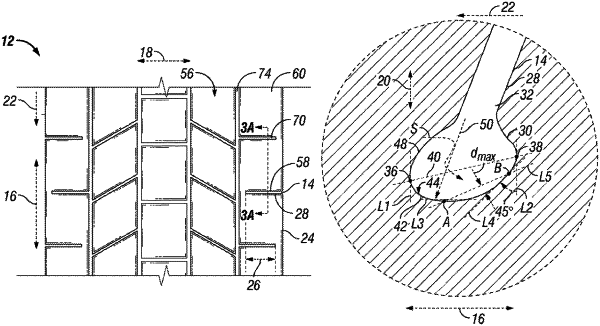| CPC B60C 11/1204 (2013.01) [B60C 11/0302 (2013.01); B60C 11/124 (2013.01); B60C 11/1281 (2013.01); B60C 2011/1227 (2013.01); B60C 2200/06 (2013.01)] | 11 Claims |

|
1. A heavy truck tire directional tread of a tire having a longitudinal direction, a lateral direction and a thickness direction, and a rolling direction in the longitudinal direction, comprising:
a tread edge;
two successive asymmetrical sipes in the longitudinal direction that share at least some of the same offset from the tread edge in the lateral direction, wherein each of the two asymmetrical sipes are arranged to have:
a body; and
a tear drop located at a bottom end of the body, wherein the tear drop has a forward tangent line L1 and a rearward tangent line L2 wherein one of which extends in the thickness direction, wherein the forward tangent line L1 is parallel to the rearward tangent line, wherein the forward tangent line L1 extends through a left tangent point and wherein the rearward tangent line L2 extends through a right tangent point, wherein an equator is a straight line that extends through the left and right tangent points, wherein a bottom of the tear drop is the portion of the tear drop bounded by the equator and closer to a center of the tire than a remaining top portion of the tear drop on an opposite side of the equator that is farther from the center of the tire; wherein the bottom has a surface that has a radius of curvature that is not the same along the entire surface of the bottom;
wherein S is an area bounded by the equator and the surface of the bottom, and wherein a reference radius Rref is calculated as follows:
 wherein line L3 is perpendicular to the thickness direction and extends through a tangent point A at the surface of the bottom;
wherein tangent point B is at the surface of the bottom in a direction from tangent point A opposite to a rolling direction, and line L4 extends through tangent point B and is oriented at a 45 degree angle to the thickness direction;
wherein line L5 extends through tangent point A and tangent point B;
wherein dmax is the maximum distance between line L5 and the surface of the bottom as measured perpendicular to line L5;
wherein dA.B. is the straight-line distance along line L5 from tangent point A to tangent point B;
wherein an average radius between tangent point A and tangent point B RA.B. avg is calculated as follows:
 wherein RA.B. avg>1.4×Rref;
wherein the entire surface of the bottom is completely concave in shape from the left tangent point to the right tangent point, and wherein a top surface of the top portion is concave in shape at locations that engage the left tangent point and the right tangent point; and
wherein the equator extends a greater distance in the longitudinal direction than in the thickness direction, and wherein a left surface of the teardrop that extends from tangent point A through the left tangent point to the body is asymmetric as compared to a right surface of the teardrop that extends from tangent point A through the right tangent point to the body.
|